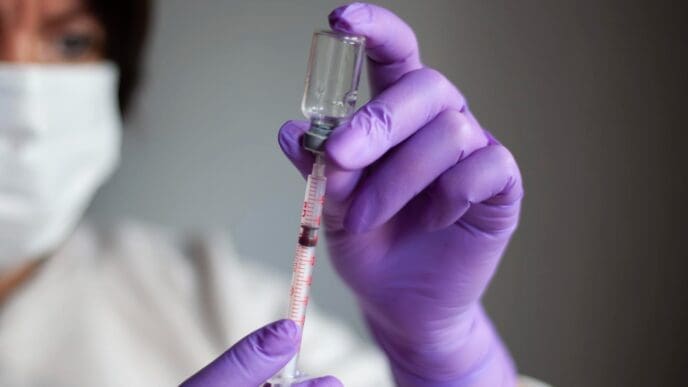For millions of women, feelings of anxiety are not just a random psychological event but are deeply intertwined with the cyclical ebbs and flows of their own biology. This powerful connection is driven by hormonal fluctuations that occur throughout a woman’s life, from puberty through menopause, directly influencing the brain’s mood-regulating chemistry. While anxiety can have many causes, understanding why and when these hormonal shifts can trigger or exacerbate it empowers women to recognize the pattern, validate their experience, and seek targeted strategies for relief.
The Brain-Hormone Connection: A Chemical Conversation
To understand hormone-driven anxiety, it’s essential to see hormones as powerful chemical messengers. Produced by the endocrine system, they travel through the bloodstream, delivering instructions to various parts of the body, including the brain.
Two primary female sex hormones, estrogen and progesterone, are the main conductors of this orchestra. Their primary job is to regulate the reproductive cycle, but their influence extends far beyond the uterus. They have a profound impact on neurotransmitters—the brain’s own chemical messengers responsible for mood, focus, and emotional stability.
Key neurotransmitters influenced by these hormones include serotonin, often called the “feel-good” chemical; GABA (gamma-aminobutyric acid), which has a calming, inhibitory effect on the nervous system; and dopamine, which is linked to pleasure and motivation. When hormone levels are stable, this intricate system works smoothly. When they fluctuate, the entire chemical balance can be disrupted, leaving the brain more vulnerable to anxiety.
Anxiety Across a Woman’s Lifespan
The link between hormones and anxiety often becomes most apparent during key transitional phases of a woman’s reproductive life. Each stage presents a unique hormonal landscape with distinct challenges.
Puberty: The First Surge
Puberty marks the beginning of significant hormonal activity. The brain signals the ovaries to begin producing estrogen and progesterone, and this initial surge can be turbulent. For many adolescent girls, this period is associated with heightened emotional sensitivity, mood swings, and the first emergence of anxiety symptoms as their brains and bodies adapt to these powerful new chemical signals.
The Menstrual Cycle: A Monthly Rhythm
Perhaps the most well-known example of the hormone-anxiety link is the monthly menstrual cycle. In the first half of the cycle, the follicular phase, estrogen levels rise, which often corresponds with a more positive and stable mood. However, after ovulation, during the luteal phase, progesterone rises and then both hormones plummet in the days leading up to menstruation.
This premenstrual drop is what triggers the symptoms of Premenstrual Syndrome (PMS), which for many women includes irritability, sadness, and significant anxiety. For some, these symptoms are severe enough to warrant a diagnosis of Premenstrual Dysphoric Disorder (PMDD), a debilitating condition where anxiety, depression, and mood swings can severely impact daily functioning.
Pregnancy and the Postpartum Period
Pregnancy involves a massive and sustained increase in both estrogen and progesterone, reaching levels far higher than at any other time. For some women, these high, stable levels can have a protective, mood-stabilizing effect. For others, the sheer magnitude of this hormonal shift can contribute to anxiety during pregnancy.
The real challenge often comes after delivery. In the first few days postpartum, estrogen and progesterone levels crash dramatically. This sudden hormonal withdrawal is a primary biological driver of postpartum anxiety and depression, affecting a significant number of new mothers. This is a physiological event, not a sign of personal failure, and it often requires support and intervention.
Perimenopause and Menopause: A Period of Transition
Perimenopause, the transition to menopause that can begin in a woman’s late 30s or 40s, is often the most challenging period for hormone-related anxiety. During this time, hormone production becomes erratic and unpredictable. Estrogen levels can swing wildly from high to low, creating a chaotic internal environment.
This fluctuation directly impacts serotonin levels and disrupts the body’s stress response system. As a result, many women experience new or worsening anxiety, panic attacks, heart palpitations, and sleep disturbances for the first time in their lives. These symptoms are often dismissed as “just stress,” but they are frequently rooted in the profound hormonal shifts of this life stage.
A Deeper Look at the Hormonal Players
Understanding the specific roles of each hormone can further clarify why their fluctuations are so impactful on mental well-being.
Estrogen: The Mood Modulator
Estrogen is a powerful player in mental health. It increases the production of serotonin and boosts the number of serotonin receptors in the brain, effectively making the brain more sensitive to this mood-lifting neurotransmitter. It also has a positive effect on dopamine.
When estrogen levels are high and stable, mood tends to be more positive. When they drop or fluctuate erratically, as they do before a period or during perimenopause, the resulting dip in serotonin activity can lead directly to feelings of anxiety, irritability, and depression.
Progesterone: The Calming Agent
Progesterone’s influence is more subtle but equally important. The body breaks progesterone down into a metabolite called allopregnanolone. This substance interacts with GABA receptors in the brain, producing a calming, anti-anxiety effect similar to that of benzodiazepine medications like Valium.
This is why the rise in progesterone after ovulation can have a soothing effect. However, when progesterone levels fall sharply before menstruation or fluctuate during perimenopause, the loss of this natural calming agent can leave the nervous system feeling overstimulated and anxious.
Cortisol and the Stress Response
Cortisol is the body’s primary stress hormone, released by the adrenal glands via the HPA (hypothalamic-pituitary-adrenal) axis. Estrogen plays a key role in helping to regulate cortisol levels. When estrogen is low, as it is during menopause, cortisol regulation can become less efficient.
This can lead to a more pronounced physical stress response—a racing heart, shallow breathing, and a feeling of being on “high alert”—even in the absence of a significant external stressor. This dysregulated cortisol response is a major contributor to the anxiety experienced during the menopausal transition.
Actionable Strategies for Managing Hormonal Anxiety
Recognizing that your anxiety has a hormonal component is the first step. The next is to find effective ways to manage it. A multi-pronged approach that includes lifestyle adjustments and, when necessary, medical support is often most effective.
Lifestyle and Behavioral Interventions
Diet and Nutrition: Stabilizing blood sugar is crucial, as blood sugar dips can mimic or worsen anxiety. Focus on a diet rich in complex carbohydrates, lean protein, and healthy fats. Reducing caffeine, processed sugar, and alcohol—all of which can disrupt hormones and trigger anxiety—is also highly beneficial.
Consistent Exercise: Regular physical activity is one of the most powerful tools for managing anxiety. It helps regulate cortisol, boosts mood-enhancing endorphins, and improves sleep quality. A mix of cardiovascular exercise, strength training, and restorative practices like yoga can be particularly effective.
Prioritize Sleep: Hormonal fluctuations, especially during perimenopause, can wreak havoc on sleep, and poor sleep dramatically worsens anxiety. Practicing good sleep hygiene—maintaining a consistent schedule, creating a dark and cool environment, and avoiding screens before bed—is essential for hormonal and mental health.
Stress Management Techniques: Practices like mindfulness meditation, deep breathing exercises, and journaling can help calm the nervous system. These techniques train the brain to respond less reactively to feelings of anxiety, giving you a sense of control even when hormones are in flux.
Medical and Therapeutic Support
Talk to Your Doctor: It is vital to discuss your symptoms with a healthcare provider, such as a gynecologist or primary care physician. They can help rule out other potential causes, like a thyroid disorder, and discuss treatments. Tracking your symptoms alongside your menstrual cycle or life stage can provide valuable data for this conversation.
Therapy: Cognitive Behavioral Therapy (CBT) is a highly effective, evidence-based treatment for anxiety. It helps you identify and reframe the negative thought patterns that fuel anxiety, providing you with practical coping skills.
Medication and Supplements: For severe PMS or PMDD, antidepressants like SSRIs (Selective Serotonin Reuptake Inhibitors) can be very effective. For perimenopausal and menopausal anxiety, Hormone Replacement Therapy (HRT) can be a transformative option for many women, as it works by stabilizing the underlying hormonal fluctuations. Certain supplements, like magnesium and B-complex vitamins, may also offer support, but should be discussed with a doctor first.
Conclusion: Validation and a Path Forward
The connection between a woman’s hormones and her mental state is not imagined; it is a fundamental aspect of her physiology. The anxiety that surfaces during specific times of the month or during major life transitions is a real, biologically-driven experience. By understanding this link, women can move past self-blame and confusion, armed with the knowledge to advocate for themselves. Recognizing the patterns, implementing supportive lifestyle changes, and seeking appropriate medical care can profoundly mitigate the impact of hormonal anxiety, paving the way for improved well-being and a better quality of life.












